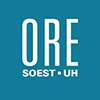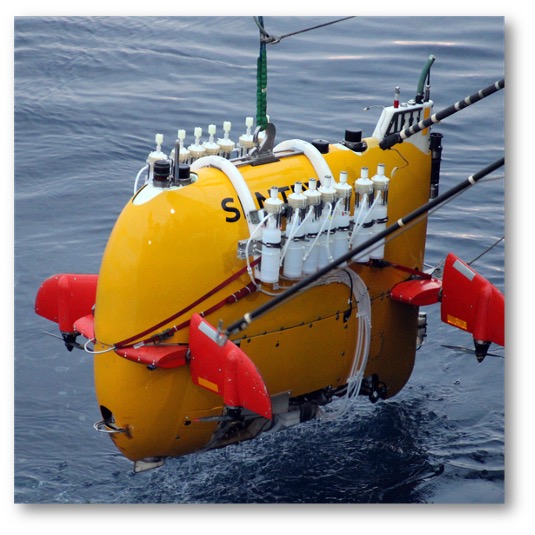To subscribe to the ORE seminar mailing list, click here.
For a (working draft) list of upcoming seminars, click here.
If you are interested in giving an ORE seminar, please contact us at nosal [at] hawaii [dot] edu.
Seminar: A Numerical Study of Effects of Perforation Layouts on Wave Energy Dissipation Caused by a Submerged Perforated Breakwater in Front of a Vertical Seawall
Bilger Hall 150 2545 McCarthy Mall, Honolulu, HI, United StatesBrady Halvorson Ph.D. Student Department of Ocean and Resources Engineering University of Hawai’i at Mānoa Location Information **This seminar will be held both in person (Bilger Hall 150) and over Zoom** https://hawaii.zoom.us/j/95081858686 Meeting ID: 950 8185 8686 Passcode: OREseminar Perforated structures are a promising alternative to standard sea walls and breakwaters for dissipating wave energy and protecting coastlines. Perforated marine structures can effectively remove wave energy from ocean waves by the energy loss associated with the flow through the perforations in the structure. Understanding the factors that may affect the hydrodynamic characteristics of flow through a perforated plate is important
Seminar: Sea Engineering’s Specializations and Projects Throughout the Pacific
Bilger Hall 150 2545 McCarthy Mall, Honolulu, HI, United StatesChis Conger Vice President of Sea Engineering Director of Engineering Division at Sea Engineering Location Information **This seminar will be held both in person (Bilger Hall 150) and over Zoom** https://hawaii.zoom.us/j/95081858686 Meeting ID: 950 8185 8686 Passcode: OREseminar Sea Engineering, Inc. (SEI) was founded in 1973 by University of Hawai‘i graduate students to provide marine-related engineering, construction, and diving services locally and throughout the broader Pacific Basin. SEI, homebased in Hawai‘i, has 50 years of experience working on coastal, marine, and waterfront projects in the Hawaiian Islands, as well as Guam, Diego Garcia, and CNMI. Our core services include geophysical
MS Plan A Defense: Fluid-Structure Interaction Analysis of an Oscillating Wave Surge Energy Converter using LS-Dyna
POST 723 1680 East-West Road, Honolulu, HI, United StatesKyle Pappas Master’s Student Department of Ocean and Resources Engineering University of Hawai’i at Mānoa **This defense will be held both in person (POST 723) and over Zoom** Meeting ID: 936 1681 5822 Passcode: KyleMS https://hawaii.zoom.us/j/93616815822 Three-Dimensional two-way coupled fluid structure interaction (FSI) analysis requires a complex strategy utilizing the finite element method (FEM) for large matrix computations. Two FEM solvers in LS Dyna are utilized to conduct a structural analysis of the Hawai’i Wave Surge Energy Converter (HAWSEC) for a particular wave condition case study that is directly compared with experimental results. The HAWSEC is a hollow, surface piercing,
MS Plan B Defense: Feasibility of Retrofitting Tinian Breakwater in CNMI
POST 723 1680 East-West Road, Honolulu, HI, United StatesZachary Niezgodski Master’s Student Department of Ocean and Resources Engineering University of Hawai’i at Mānoa **This defense will be held both in person (POST 723) and over Zoom** Meeting ID: 917 8926 7508 Passcode: ZachMS https://hawaii.zoom.us/j/91789267508 Since construction of the Tinian Harbor in 1945, there have only been minor repairs to the original facilities, resulting in many becoming damaged and degraded. Looking to the future, the U.S. Department of Defense, specifically the Department of the Navy, has plans to upgrade logistics capacity on Tinian for offload operations, and thus is most interested in projects that will improve the port facilities.
Seminar: Apra Harbor Improvement Project Part 1: Phase 1-Conceptual Design
Bilger Hall 150 2545 McCarthy Mall, Honolulu, HI, United StatesClara Encke, Elizabeth Hauschild, Jomphol Lamoonkit, Will Robert, Merritt Shepherd, Guilherme Silva, Bethany Stafford, and Charlotte White ORE 783 Capstone Design Department of Ocean & Resources Engineering University of Hawai‘i at Mānoa Location Information **This seminar will be held both in person (Bilger Hall 150) and over Zoom** https://hawaii.zoom.us/j/95081858686 Meeting ID: 950 8185 8686 Passcode: OREseminar Students in the ORE 783 Capstone class have been working on the Apra Harbor Improvement Project. Apra Harbor is an economic and military hub located on the west coast of Guam. The current configuration of Apra Harbor does not provide adequate wave protection to
Seminar: Apra Harbor Improvement Project Part 2
Clara Encke, Elizabeth Hauschild, Jomphol Lamoonkit, Will Robert, Merritt Shepherd, Guilherme Silva, Bethany Stafford, and Charlotte White ORE 783 Capstone Design Department of Ocean & Resources Engineering University of Hawai‘i at Mānoa Location Information **This seminar will be held both in person (Bilger Hall 150) and over Zoom** https://hawaii.zoom.us/j/95081858686 Meeting ID: 950 8185 8686 Passcode: OREseminar Students in the ORE 783 Capstone class have been working on the Apra Harbor Improvement Project. Apra Harbor is an economic and military hub located on the west coast of Guam. The current configuration of Apra Harbor does not provide adequate wave protection to
MS Plan B Defense: Infrastructure for a Dataset to Improve Tagging and Mapping of Low-Flying Aircraft via Acoustic and Radio Broadcast Data
Wyatt Burkley Master’s Student Department of Ocean and Resources Engineering University of Hawai’i at Mānoa **This defense will be held remotely over Google Meet** Google Meet Link: meet.google.com/wor-pdyq-eos Since construction of the Tinian Harbor in 1945, there have only been minor repairs to the original facilities, resulting in many becoming damaged and degraded. Looking to the future, the U.S. Department of Defense, specifically the Department of the Navy, has plans to upgrade logistics capacity on Tinian for offload operations, and thus is most interested in projects that will improve the port facilities. This study focuses on a potential upgrade of
Seminar: Numerical wave modeling for Pacific Islands
Bilger Hall 150 2545 McCarthy Mall, Honolulu, HI, United StatesNing Li Ocean Wave Model Systems Specialist Department of Ocean and Resources Engineering University of Hawaii at Manoa Location Information **This seminar will be held both in person (Bilger Hall 150) and over Zoom** https://hawaii.zoom.us/j/95081858686 Meeting ID: 950 8185 8686 Passcode: OREseminar Hawaii is typical of most Pacific Islands with a complex wave climate containing a mix of persistent trade wind seas, year-round south swells, seasonal north swells, and storm waves from subtropical and tropical cyclones passing nearby. The steep volcanic islands modulate the wind fields to create regional wave patterns with large spatial variation. Wave-rider buoys were installed around
Seminar: Observing the Ocean and Earth with SMART Subsea Cables: SMART Atlantic CAM
Bilger Hall 150 2545 McCarthy Mall, Honolulu, HI, United StatesFernando Carrilho Division of Geophysics, Portuguese Institute for Sea and Atmosphere Jose Barros Telecommunications Consulting Bruce Howe Ocean and Resources Engineering, University of Hawaii at Manoa Location Information **This seminar will be held both in person (Bilger Hall 150) and over Zoom** https://hawaii.zoom.us/j/95081858686 Meeting ID: 950 8185 8686 Passcode: OREseminar The ocean is key to understanding climate change, sea level rise, ocean warming, tsunamis, and earthquakes. Because the ocean is difficult and costly to monitor, we lack fundamental data needed to adequately model, understand, and address these threats. Science Monitoring And Reliable Telecommunications (SMART) Cables is working to integrate sensors
Seminar: WVNet: A SAR Foundational Model with Applications for Air-sea Interaction Research
Marine Science Building 100 1000 Pope Road, Honolulu, HI, United StatesYannik Glaser PhD Candidate in Information and Computer Science Department of Atmospheric Sciences University of Hawai’i at Mānoa Justin Stopa Associate Professor Department of Ocean and Resources Engineering University of Hawai’i at Mānoa Location Information **This seminar will be held both in person (Marine Sciences Building 100) and over Zoom** Zoom Invitation Link: https://hawaii.zoom.us/j/98919200762 Meeting ID: 989 1920 0762 Passcode: 201326 Synthetic aperture radars (SAR) aboard space-borne satellites measure sub-mesoscale oceanic and atmospheric phenomena at a global scale. This work uses the European Space Agency (ESA) Sentinel-1 (S-1) SAR mission’s sea surface roughness to study sub-mesoscale phenomena such as turbulence
Seminar: Miniature Soft Robotic Systems Towards Complex Fluidic Environments
Bilger Hall 150 2545 McCarthy Mall, Honolulu, HI, United StatesTianlu Wang Assistant Professor Department of Mechanical Engineering University of Hawai’i at Mānoa Location Information **This seminar will be held both in person (Bilger Hall 150) and over Zoom** https://hawaii.zoom.us/j/95081858686 Meeting ID: 950 8185 8686 Passcode: OREseminar The emerging field of miniature soft robots with unprecedented maneuverability, adaptation, and safe interactions with surrounding environments has endowed new platforms to overcome critical challenges in hard-to-reach marine and biomedical scenarios. Focusing on system-level construction, we first synergized soft actuators and bio-inspired structures to create small-scale soft robots emulating larval zebrafish and jellyfish. A class of magnetically actuated laval fish-like milliswimmers was investigated
Seminar: Robotic Oceanography: Revealing Hydrothermal Influence on Ocean Biogeochemistry
POST 723 1680 East-West Road, Honolulu, HI, United StatesJohn "Chip” Breier, Ph.D., P.E. Professor School of Earth, Environmental, and Marine Sciences The University of Texas Rio Grande Valley The ocean water column contains gradients that are difficult to resolve using observing platforms commonly employed for marine biogeochemical and microbiology studies. These studies have relied heavily on wire-deployed platforms inherently limited in spatial and temporal resolution. When autonomous robotic vehicles are equipped with sufficient integrated sampling capacity, they overcome these limitations and can target biogeochemical and biochemical gradients in the water column in ways not previously possible. This challenge has been particularly critical to overcome in the deep sea

